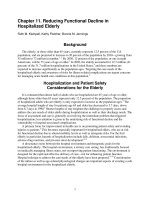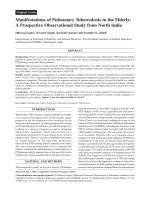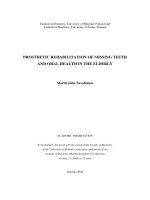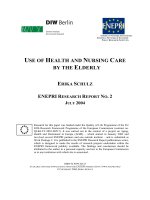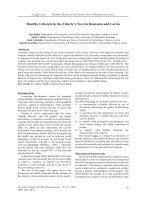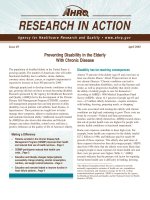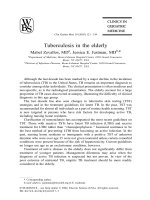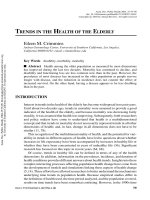Stroke in the Elderly ppt
Bạn đang xem bản rút gọn của tài liệu. Xem và tải ngay bản đầy đủ của tài liệu tại đây (5.17 MB, 48 trang )
W
orld Stroke
Academy
1
Stroke in the Elderly
Stephen Davis, Kennedy Lees, Richard Lindley
Stroke in the Elderly
W
orld Stroke
Academy
2
Table of contents
1. Impact, burden and risk factors 3
1.1. Prevalence and incidence 4
1.2. Role of age in outcomes and burden 6
1.3. Ageing-related risk factors 10
1.4. Deningtheelderlypopulation 11
1.5. Summary 13
1.6. References 15
2. Acute stroke care 16
2.1. Intravenous alteplase therapy 17
2.2. Very elderly in clinical trials 18
2.3. Outcomes of thrombolytic therapy in the elderly 20
2.4. Newer treatments for stroke 23
2.5. Current recommendations for the elderly 25
2.6. Summary 26
2.7. References 28
3. Long-term care 30
3.1. Fundamentals of long-term post-stroke care 31
3.2. Age-related disparities in treatment 38
3.3. Challenges of rehabilitation and the elderly 41
3.4. Long-term and palliative care 43
3.5. Summary 45
3.6. References 47
Stroke in the Elderly
Stroke in the Elderly
W
orld Stroke
Academy
3
1. Impact, burden and risk factors
1. Impact, burden and risk factors
W
orld Stroke
Academy
4
1. Impact, burden and risk factors
1.1 Prevalence and incidence
▪ According to the World Health Organisation (WHO), approx-
imately 15 million people suffer from stroke each year (1).
▪ Of these, 5 million die and another 5 million are permanently
disabled (Figure 1).
1. Impact, burden and risk factors
Learning objectives
● Gain insight into the prevalence, incidence and economic
impact of stroke in the elderly.
● Learn about the role of age in stroke outcomes and burden.
● Be aware of the age-related risk factors for stroke.
● Provide a denition for the elderly population, and know
what challenges are involved in this process.
Figure 1: Stroke is common worldwide
15 million people
suffer from stroke
each year
W
orld Stroke
Academy
5
▪ Cardiovascular diseases (stroke and ischaemic heart disease)
are the leading cause of death in the world.
▪ Stroke alone is the second leading cause of death, responsible
for 5.7 million deaths in 2004 and translating to 9.7% of all
deaths worldwide.
▪ Mortality rates for coronary heart disease and acute myocardial
infarction continue to decrease, but mortality rates for stroke
havenotchangedsignicantlyduringthepast10years.
▪ Around the world, the majority of strokes (75% to 89%) occur in
those over 65 years of age (Figure 2) (2, 3).
▪ For each decade of life after age 55, the stroke rate doubles in
both men and women (4).
1. Impact, burden and risk factors
Figure 2: Majority of strokes occur in those aged >65yrs
The majority of
strokes occur in
the over 65s
W
orld Stroke
Academy
6
1. Impact, burden and risk factors
1.2 Role of age in outcomes and burden
▪ Stroke is the 6
th
leading cause of disability or burden worldwide
in terms of DALYS (disability-adjusted life years) (1).
▪ This represents a loss of 46.6 million years of healthy life (1).
▪ Stroke also ranks as the third most common cause of burden in
middle- and high-income countries, following depressive disorders
and ischaemic heart disease (1).
▪ These 3 diseases are predicted to move up the rankings to
become 3 of the 4 leading causes of disease and injury burden
by 2030 (1).
▪ In a study of individuals aged 65 and older in 7 low- and middle-
income countries (including China, India, Cuba, Dominican
Republic, Venezuela, Mexico, and Peru), stroke was found to be
the second-largest contributor to disability, following dementia (5).
Figure 3: Contribution of stroke to disability
Stroke is the 6
th
leading cause
of disability or
burden worldwide
W
orld Stroke
Academy
7
1. Impact, burden and risk factors
▪ Paralysis or weakness of the limbs was also found to be a
large contributor to disability, although many of these cases
were thought to be related to stroke (5).
▪ Furthermore, it was found that in these 7 countries, stroke was
the 4
th
most common diagnosis, following hypertension, diabetes
and dementia (5).
▪ An ageing population will increase the prevalence of stroke and
its associated burden.
▪ By 2050, the global population over 60 years of age is projected
to approach 2 billion, compared with 629 million in 2002
(Figure 4) (6).
▪ 54% of those aged >60 years reside in Asia; 24% in Europe.
▪ The fastest growing segment of the older population is people
aged≥80years,whichcomprised12%oftheworldpopulation
in 2002 and is projected to reach 19% in 2050 (6).
Figure 4: The ageing population will increase the burden of stroke globally
With the aging
population,
the prevalence
of stroke will
increase
W
orld Stroke
Academy
8
1. Impact, burden and risk factors
▪ Thenumberofcentenarians(≥100years)isprojectedto
increase 15-fold (6)
▪ The management of stroke in the elderly is becoming an
important consideration for healthcare professionals and
providers, not only because of increasing incidence and
prevalence, but also due to poorer outcomes in this age group.
– Medical outcomes following stroke, such as disability and
mortality, have been noted to worsen with age.
– Those over 80 years of age, who have a stroke, are more
likely to die in hospital and less likely to have favourable
long-term recovery compared to younger survivors.
– A study by Olindo and colleagues, of all patients with
rst-everstroke,observedthatthose≥85yearsofagehad
signicantly greater disability approximately 1 week after
stroke and signicantly higher mortality during the rst 2
months after stroke compared with those <85 years
(Figure 5) (7).
– Among those who survived the rst 2 months, older
survivors were more likely to have moderate to severe
disability than younger survivors (7).
– Poor health and pre-stroke disability in the elderly may
contribute to the poorer outcome in this age group (7).
– Thesendingsdemonstratethattheelderlyrequireaccess
tohighqualitystrokecareifoutcomesaretobeimproved.
The elderly
require access
to high-quality
stroke care
Outcomes after
a stroke tend to
worsen with age
W
orld Stroke
Academy
9
1. Impact, burden and risk factors
▪ Post-stroke differences between elderly and younger survivors
persist following stroke.
▪ Results from the Copenhagen Stroke Study showed that survival
issignicantlyloweramongthose≥85yearsofagecompared
with younger survivors through more than 5 years after stroke
(Figure 5) (8).
Figure 5: Differences in survival persist for years following stroke
▪ Elderly survivors are more likely to experience certain post-
stroke disabilities compared with younger survivors, including (9):
– Confusion
– Paralysis
– Languagedecits
– Swallowing problems
– Urinary incontinence
W
orld Stroke
Academy
10
1. Impact, burden and risk factors
1.3 Ageing-related risk factors
▪ Therearesignicantageing-relatedriskfactorsforstroke,and
riskfactorprolesandmechanismsofischaemicinjurydiffer
between younger and elderly patients (Figure 6) (10).
▪ The incidence of ischaemic stroke is higher in men <80 years
compared with women, whereas after 80 years of age, women
have a higher incidence (4,8)
▪ Riskfactorsforischaemicstroke,suchasatrialbrillation,
congestive heart disease, and carotid artery stenosis, increase
sharply with age (10).
▪ In addition, age-related changes within the central nervous system
may render the elderly more sensitive to ischaemic damage (10).
▪ Axonal pathways are injured in most strokes and contribute
importantlytoclinicaldecits(10).
▪ Central nervous system atrophy that begins in midlife may
reduce cerebrovascular reserves, leaving the brain more
susceptibletovascularinsufciencyandischaemicinjuryto
these pathways (11).
Figure 6: Risk factors for rst-ever stroke in the elderly
Risk factor proles
for stroke differ
between elderly
and younger
patients
W
orld Stroke
Academy
11
1. Impact, burden and risk factors
1.4 Dening the elderly population
▪ Studies vary widely in the age ranges used to designate older
or elderly patients; from 60 to 65 years of age, to 75, 80, or 85
years of age.
▪ Even within these ranges of older patients, the incidence,
prevalence, risk factors, and prognosis for stroke can differ.
▪ Astudyofcardiovascularriskprolesinpatientsolderand
younger than 85 years found that congestive heart failure,
chronic renal disease, previous cerebrovascular disease and
atrialbrillationweresignicantlyassociatedwithstrokeinthe
very old, whereas risk factors such as diabetes, hypertension,
hyperlipidaemia and heavy smoking were less relevant to older
patients (Figure 7) (12).
▪ Similar results were found in a study, which looked at patients
younger and older than 80 years.
Figure 7: Risk factors vary with age
CHF, chronic renal
disease, previous
CV disease and
AF are strongly
associated with
stroke in the elderly
W
orld Stroke
Academy
12
1. Impact, burden and risk factors
▪ Itisworryingtondthatelderlystrokesurvivorsmaynotreceive
the same level of care as younger survivors.
▪ Results from a European Union Concerted Action study in 7
countries involving 4,499 patients who were hospitalised for
arststrokefoundthattheuseofinvestigationsduringinpatient
carewassignicantlyloweramongoldersurvivors(9).
▪ Signicantlyfewersurvivors85yearsofageorolderreceived
brain imaging, Doppler examination, echocardiogram, and
angiography (Figure 8) (9).
▪ Surgical interventions, such as carotid surgery, were also less
frequentlyperformedintheelderly(9).
▪ Beyond these initial assessments, evidence suggests that
elderly survivors have less access to other key elements of
post-stroke care.
Figure 8: Older patients may receive less care
Elderly stroke
patients tend to
undergo less
investigations
and interventions
compared with
younger patients
W
orld Stroke
Academy
13
1. Impact, burden and risk factors
▪ An evaluation of stroke services in the United Kingdom showed
that those 85 years of age or older were less likely to be treated
in a stroke unit or to receive secondary prevention, and also
less likely to receive some aspects of rehabilitation.
▪ Eachoftheseelementsofpost-strokecarehasshownbenets
regardless of age.
1.5 Summary
▪ Stroke has high global prevalence that is increasing with the
ageing of worldwide populations, and which is associated with
a high economic burden.
▪ With increased age, the incidence of stroke increases while
outcomes worsen.
▪ This may be related to the fact that certain risk factors for
ischaemic stroke, as well as age-related changes within the
central nervous system, are increased with age.
▪ The elderly and the oldest old are subject to different conditions
andrisks,andshouldbeexaminedseparatelyforuniquerisk
factors and patterns so that acute and long-term post stroke
care can be optimised for this growing population.
W
orld Stroke
Academy
14
1. Impact, burden and risk factors
Self assessment 1.1
Which of the following statements concerning the prevalence and inci-
dence of stroke are correct?
According to the World Health Organisation (WHO),
approximately 15 million people suffer from stroke each year
Stroke alone is the leading cause of death
Mortality rates for stroke continue to decrease
Around the world, the majority of strokes (75% to 89%) occur
in those over 65 years of age
For each decade of life after age 55, the stroke rate doubles in
both men and women
●
●
●
●
●
Self assessment 1.2
Which of these statements concerning the access of elderly stroke
patients to investigations and treatment are correct?
The use of investigations during inpatient care is much higher
among older survivors
Significantly fewer survivors 85 years of age or older receive
brain imaging, Doppler examination, echocardiogram, and
angiography
Surgical interventions, such as carotid surgery, are more
frequentlyperformedintheelderly
Elderly survivors have less access to other key elements of
post-stroke care
Patients 85 years of age or older were less likely to be treated
in a stroke unit or to receive secondary prevention, and also
less likely to receive some aspects of rehabilitation
●
●
●
●
●
W
orld Stroke
Academy
15
1.6 References
1. World Health Organization. The Global Burden of Disease. 2004 Update. Geneva,
Switzerland: WHI Press; 2008.
2. Feigin VL, Lawes CM, Bennett DA, Anderson CS. Stroke epidemiology: a review
of population-based studies of incidence, prevalence, and case-fatality in the late
20
th
century. Lancet Neurol 2003;2(1):43-53.
3. Rosamond W, Flegal K, Furie K, et al. Heart disease and stroke statistics 2008
update: a report from the American Heart Association Statistics Committee and
Stroke Statistics Subcommittee. Circulation 2008;117(4):e25-146.
4. Rojas JI, Zurru MC, Romano M, et al. Acute ischemic stroke and transient ischemic
attackintheveryold riskfactorproleandstrokesubtypebetweenpatientsolder
than 80 years and patients aged less than 80 years. Eur J Neurol 2007;14(8):
895-899.
5. Sousa RM, Ferri CP, Acosta D, et al. Contribution of chronic diseases to disability
in elderly people in countries with low and middle incomes: a 10/66 Dementia
Research Group population-based survey. Lancet 2009;374(9704):1821-1830.
6. United Nations, Population Division, Department of Economic and Social Affairs.
POPULATION AGEING-2002. Presented at: the Second World Assembly on
Ageing; 2007; Madrid, Spain.
7. Olindo S, Cabre P, Deschamps R, et al. Acute stroke in the very elderly. Stroke
2003;34:1593-1597.
8. Kammersgaard LP, Jorgensen HS, Reith J, et al. Short- and long-term prognosis
for very old stroke patients. The Copenhagen Stroke Study. Age Ageing 2004;
33(2):149-154.
9. DiCarlo A, Lamassa M, Pracucci, et al. Stroke in the very old: clinical presentation
and determinants of 3-month functional outcome: A European perspective.
European BIOMED Study of Stroke Care Group. Stroke 1999;30(11):2313-2319.
10. Chen RL, Balami JS, Esiri MM, et al. Ischemic stroke in the elderly: an overview of
evidence. Nat Rev Neurol 2010;6(5):256-265.
11. Baltan S, Besancon EF, Mbow B, et al. White matter vulnerability to ischemic injury
increases with age because of enhanced excitotoxicity. J Neurosci 2008;28(6):
1479-1489.
12. Arboix A, Miguel M, Ciscar E, et al. Cardiovascular risk factors in patients aged 85
or older with ischemic stroke. Clin Neurol Neurosurg 2006;108(7):638-643.
1. Impact, burden and risk factors
W
orld Stroke
Academy
16
2. Acute stroke care
2. Acute stroke care
W
orld Stroke
Academy
17
2. Acute stroke care
2.1 Intravenous alteplase therapy
▪ Clot lysis with alteplase (recombinant tissue plasminogen
activator, rt-PA) is the only approved therapy for acute ischaemic
stroke (1).
▪ Intravenous treatment with alteplase, started soon after stroke
onset, has been shown to be safe and effective in randomised
controlled trials (2,3).
▪ An analysis of pooled data from all trials including the recent
ECASS3studyconrmedthatalteplasehasafavourable
risk-benetratioupto4.5hoursfromstrokeonset(Figure1)(4).
• However,the earlier treatment is given, the better the outcome.
▪ The odds of favourable 3-month outcome measured on the
modiedRankinscaleincreaseasthetimebetweenstroke
onset and start of treatment gets shorter (4).
2. Acute stroke care
Figure 1: Early thrombolysis with alteplase improves outcomes
The earlier treat-
ment is given, the
better the outcome
Alteplase is the
only approved clot
lysis therapy for
acute ischaemic
stroke
W
orld Stroke
Academy
18
▪ There is a positive association between mortality and time
tostartoftreatmentbutnosignicantincreaseindeaths
unless treatment is commenced beyond 4.5 hours (4).
▪ The risk of large intracranial haemorrhage does not appear to
besignicantlyassociatedwithtimetoinitiationoftreatment(4).
2. Acute stroke care
2.2 Very elderly in clinical trials
▪ Inevitably, compared to the young, older people suffer more
from any health challenge and have poorer outcomes. This
also applies to patients who receive thrombolysis.
▪ A prospective study of stroke patients treated with intravenous
alteplase showed that those aged 80 and older had more than
twice the mortality rate compared with patients younger than
80 years, and were only half as likely to achieve a favourable
outcome (5).
▪ However,thisagedifferencelikelyreectsconfounding
factors such as case mix and comorbidity as we will see later.
▪ Unfortunately,theelderly,whorepresentasignicantand
increasing proportion of patients who might be eligible for
andbenetfromthrombolytictreatment,havebeenunder-
represented in the large, randomised, controlled trials of
alteplase (6).
▪ Only 137 patients aged 80 years or older were available for
pooled analysis.
▪ With only small numbers of very elderly patients in the NINDS
and other trials, analysis of the randomised controlled trial
datainthissub-populationisequivocal.
▪ Itrevealscomparablebenetsfromtreatmentintheyoung
and elderly cohorts after adjusting for differences in prognostic
factors such as baseline severity (Figure 2) (7).
The elderly are
under-represented
in clinical trials
W
orld Stroke
Academy
19
2. Acute stroke care
▪ TheunadjustednumbersforthemodiedRankinscoresare
slightly lower in the elderly cohort; however, more of the elderly
patients with severe stroke were allocated to alteplase inter-
vention rather than placebo (7).
Figure 2: Outcomes for alteplase versus placebo in randomised controlled trials
by age
In a pooled
analysis of
alteplase therapy,
adjusted outcomes
were comparable
in elderly and
younger cohorts
W
orld Stroke
Academy
20
2. Acute stroke care
2.3 Outcomes of thrombolytic therapy in the elderly
▪ An analysis of patients in the large Virtual International Stroke
TrialsArchive,VISTArevealsthatthebenetofalteplase
therapy is comparable in elderly and young patients and
extends across the range of possible outcomes (Figure 3) (7).
▪ Thisanalysisnotonlyshowedtheinuenceofagealoneon
outcome - the elderly have much higher short-term mortality
than younger patients and less chance of good outcome - but
also that the effect of treatment with alteplase is just as great in
older patients as in patients aged under 80 years (Figure 3) (7).
▪ Whilerandomisedcontrolledtrialdataofthrombolysisefcacy
have limited numbers of older adults, more comprehensive
outcome data from this cohort come from published but
uncontrolled cohort studies and analyses of stroke registries.
Figure 3: Outcomes in thrombolysed patients versus controls: VISTA
VISTA reveals that
alteplase benets
are comparable
in young and old
patients
W
orld Stroke
Academy
21
2. Acute stroke care
▪ Although the European Safe Implementation of Thrombolysis
in Stroke Monitoring Study, known as SITS-MOST, excluded
patients 80 years and older due to age restrictions of the
European marketing licence for alteplase (8), thrombolysis
outcomes for older patients have been included in the SITS
International Stroke Thrombolysis Register (SITS-ISTR) (9).
▪ A comparison of alteplase-treated patients in the SITS registry
versus control patients from VISTA reported comparable
benetofthrombolysisinelderlyandyoungerpatientsafter
adjustment for baseline prognostic factors (10).
▪ ThedistributionsofmodiedRankinscoresweresignicantly
better with alteplase treatment versus controls both for
patients younger than 80 years of age and for those over 80,
with comparable odds ratios of 1.6 and 1.4, respectively
(Figure 4) (10).
▪ Further analysis of these data by age decile showed no loss
ofefcacywithadvancingage(10).
Figure 4: Thrombolysis efcacy similar across age groups in VISTA and
SITS-ISTR
Adjusted mRS
scores after
alteplase treatment
are signicantly
better in all age
groups compared
to controls
W
orld Stroke
Academy
22
2. Acute stroke care
▪ An analysis of safety of intravenous alteplase use in the
elderlybytheSITSgroupconrmsthatalthoughbleeding
after thrombolysis may be less common in younger patients,
the very elderly – those aged over 80 – are not at higher risk
than 60 to 80 year olds (11).
▪ In fact, serious bleeds may become less common in very
elderly patients, perhaps because clinicians are more cautious
in offering treatment or because intracerebral pressure effects
are less serious in older patients with some brain atrophy.
SITS shows that
patients >80 years
are not at higher
risk with alteplase
therapy than those
<80 years
W
orld Stroke
Academy
23
2. Acute stroke care
2.4 Newer treatments for stroke
▪ Newerstroketreatmentshavelimitedsafetyandefcacydata.
Intra-arterial nbrinolysis
▪ The second Prolyse in Acute Cerebral Thromboembolism
study(PROACT-II),whichlookedatinter-arterialbrinolysisin
stroke victims, excluded patients aged 85 years and older (12).
Endovascular treatments
▪ Endovascular treatments, such as intravenous and intra-
arterial thrombolysis, mechanical thrombectomy with the
Penumbra or MERCI retriever devices, and angioplasty with
expandable stents are considered by some to be promising
alternative treatments for patients ineligible for standard
intravenous thrombolytic therapy. However, just as there are
no randomised studies in the young, there are virtually no
efcacyandsafetydataavailableforthesetherapiesin
patients over 80 years old (6).
▪ This age group was even excluded from the uncontrolled
Interventional Management of Stroke study (IMS II) (13).
Hemicraniectomy
▪ Studiesofhemicraniectomy,atechniqueusedtorelieve
swelling secondary to cerebral artery infarction, also lack data
in elderly patients.
▪ The DESTINY (14), DECIMAL (15) and HAMLET (16) trials of
hemicraniectomy for cerebral infarction each excluded patients
over 60 years of age (Figure 5).
There is currently
very little efcacy
and safety data
on endovascular
treatments in the
elderly
W
orld Stroke
Academy
24
2. Acute stroke care
▪ After the observed success of hemicraniectomy in young
patients (17), a second Destiny (decompressive surgery for
the treatment of malignant infarction of the middle cerebral
artery) trial, DESTINY-II, is being conducted solely in patients
older than 60 years to remedy this gap (18).
▪ The primary endpoint of this prospective, randomised study
is the effect of decompressive hemicraniectomy versus more
conservative intensive care treatment on disability at 6 months,
basedonthemodiedRankinScale,withsecondaryout
comesat1yearindisability,functionalneurologicaldecit,
andqualityoflife(18).
Neuroprotective approaches
▪ Various proposed neuroprotective approaches to protect the
ischaemic penumbra have shown promise in animals but have
so far been unsuccessful in humans.
▪ The selection of agents for clinical testing may have been
basedoninadequateexperimentalevidence,andearlyclinical
trials may have been suboptimally designed.
Figure 5: Age limits of hemicraniectomy trials
DESTINY-II
is looking at
the effects of
hemicraniectomy
in stroke patients
>60 years
Neuroprotective
agents have so
far not been
successful in
humans
W
orld Stroke
Academy
25
2. Acute stroke care
▪ The Stroke Therapy Academic Industry Roundtable recom-
mends inter alia that future preclinical studies also be performed
on aged animals with comorbid conditions (19).
▪ Whether this is really practical has yet to be established.
2.5 Current recommendations for the elderly
▪ Overall, current recommendations from groups such as the
European Stroke Organisation (ESO) and American Heart
Association/American Stroke Association (AHA/ASA) are for
elderly patients to receive the same process of care as younger
patients, including both stroke units and early rehabilitation
(20, 21).
▪ Stroke unit care limits mortality, physical disability, and cognitive
disability, as well as the need for institutionalisation, regardless
of age (22).
▪ Early and intensive in-patient rehabilitation also offers clear
benetsregardlessofage,andisrecommendedforallpatients
by the European Stroke Organisation (Figure 6) (20).
▪ However, evidence from the National Sentinel Audit of stroke
performed in the United Kingdom showed that patients 85
years of age or older were less likely to be treated in a stroke
unit, and in the UK were less likely to undergo a brain scan
within 24 hours of stroke onset, to receive secondary prevention,
or to receive some aspects of rehabilitation (23).
▪ There is a clear need to ensure that elderly stroke patients
receive the same standard of care as younger patients.
Stroke unit care
benets all age
groups


